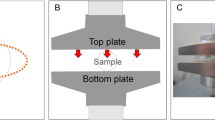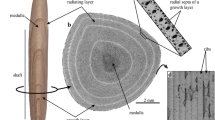Abstract
We investigated the plasticity of spines of the burrowing heart urchin Echinocardium cordatum inhabiting sandy beaches. This urchin has very specialized spines which play specific roles in feeding and locomotion. Biometrical and mechanical properties of the spine skeleton of individuals from a wave-exposed intertidal site and a protected subtidal site (Brittany, France) were compared and related to sediment grain size, food supply and urchin small-scale distribution and burrowing depth. The intertidal site was characterized by coarser sand; the urchins were more scattered and more deeply buried than in the subtidal site. Intertidal urchins were bigger than subtidal urchins but showed similar resource allocation. Spines of intertidal urchins were longer than those of subtidal urchins, their architecture was reinforced and they presented a higher fracture force and stiffness. These spine differences would be essentially due to passive plasticity, but could also be adaptative at a certain extent.






Similar content being viewed by others
References
Beukema JJ (1985) Growth and dynamics in populations of Echinocardium cordatum living in the North Sea off the Dutch north coast. Neth J Sea Res 19(2):129–134
Buchanan JB (1966) The biology of Echinocardium cordatum (Echinodermata:Spatangoidea) from differents habitats. J mar boil Ass UK 46:97–114
Buchanan JB (1967) Dispersion and demography of some infaunal echinoderm population. Symp Zool Soc London 20:1–11
Buchanan JB (1984) Sediment analysis. In: Holme NA, McIntyre AD (eds) Methods for the study of marine benthos. Blackwell, Oxford, pp 41–65
De Ridder C, Jangoux M, De Vos L (1987) Frontal ambulacral and peribuccal areas of the spatangoid echinoid Echinocardium cordatum (Echinodermata): a functional entity in feeding mechanism. Mar Biol 94:613–624
Denny MW (1988) Biology and mechanics of the wave-swept environment. Princeton University Press, Princeton
DeWitt TJ, Scheiner SM (2004) Phenotypic plasticity: functional and conceptual approaches. Oxford University Press, Oxford
Dorgan KM, Jumars PA, Johnson BD, Boudreau BP (2006) Macrofaunal burrowing: the medium is the message. Oceanogr Mar Biol Annu Rev 44:85–121
Duineveld GCA, Jenness MI (1984) Differences in growth rates of the sea urchin Echinocardium cordatum as estimated by the parameters ω of the von bertalanffy equation applied to skeletal rings. Mar Ecol Prog Ser 19:65–72
Ebert TA (1968) Growth rates of the sea urchin Strongylocentrotus purpuratus related to food availability and spine abrasion. Ecology 49:1075–1091
Ebert TA, Russel P (1994) Allometry and Model II Non-linear regression. J Theor Biol 168:367–372
Edwards PB, Ebert TA (1991) Plastic response to limited food availability and spine damage in the sea urchin Strongylocentrotus purpuratus. J Exp Mar Biol Ecol 145:295–320
Ferber I, Lawrence JM (1976) Distribution, substratum preference and burrowing behaviour of Lovenia elongata (Gray) (Echinoidea:Spatangoida) in the gulf of Elat (‘Aqaba), Red sea. J Exp Mar Biol Ecol 22:207–225
Harrold C, Reed D (1985) Food availability, sea urchin grazing and kelp forest community structure. Ecology 66:1160–1169
Hyman LH (1955) The invertebrates: echinodermata. McGraw-Hill Book Company, New York
Incera M, Cividanes SP, López J, Costas R (2003) Role of hydrodynamic conditions on quantity and biochemical composition of sediment organic matter in sandy intertidal sediments (NW Atlantic coast, Iberian Peninsula). Hydrobiologia 497:39–51
Kingsolver JG, Pfennig DW, Servidio MR (2002) Migration, local adaptation and the evolution of plasticity. Trends Ecol Evol 17:540–541
Kröncke I (2006) Structure and function of macrofaunal communities influenced by hydrodynamically controlled food availability in the Wadden sea, the open north sea, and the deep-sea. A synopsis Senckenb Maritim 36:123–164
Lawrence JM, Lane JM (1982) The utilization of nutrients by post-metamorphic echinoderms. In: Jangoux M, Lawrence JM (eds) Echinoderm nutrition. A. A. Balkema, Rotterdam, pp 331–371
Levitan DR (1988) Density-dependent size regulation and negative growth in the sea urchin Diadema antillarum Philippi. Oecologia 76:627–629
Levitan DR (1989) Density-dependent size regulation in Diadema antillarum: effects of fecundity and survivorship. Ecology 70:1414–1424
Lewis JB, Storey GS (1984) Differences in morphology and life history traits of the echinoid Echinometra lucunter from different habitats. Mar Ecol Prog Series 15:207–211
Little C (2000) The biology of soft shores and estuaries. Oxford University Press, Oxford
Nichols D (1959) Changes in the Chalk heart-urchin Micraster interpreted in relation to living forms. Phil Trans R Soc Lond B 242:347–437
Pigliucci M (1996) How organisms respond to environmental changes: from phenotypes to molecules (and vice versa). Tree 11:168–173
Pinet PR (1996) Invitation to oceanography. West Publishing Co., St. Paul
Rhoads DC (1974) Organism-sediment relations on the muddy sea floor. Oceanogr mar Biol A Rev 12:263–300
Schinner GO, Peterlik H, Hilgers H, Kromp K (1995) Structural design and mechanical properties in spines of Spatangoid Sea Urchins. Biomimetics 3:13–30
Smith AB (1980) The structure and arrangement of echinoid tubercles. Biol Sci 242:1–54
Spirlet C, Grosjean P, Jangoux M (1998) Reproductive cycle of the echinoid Paracentrotus lividus: analysis by means of the maturity index. Invertebr Reprod Dev 34(1):69–81
Strathmann RR (1981) The role of spines in preventing structural damage to echinoid tests. Paleobiology 7(3):400–406
Warner RR (1997) Evolutionary ecology: how to reconcile pelagic dispersal with local adaptation. Coral Reefs 16:115–120
Wentworth CK (1922) A scale of grade and class terms for clastic sediments. J Geol 30:377–392
Wieking G, Kröncke I (2003) Abundance and growth of the sea urchin Echinocardium cordatum in the central north sea in the late 80s and 90s. Senckenb Maritim 32:113–124
Withman DW, Agrawal AA (2009) What is phenotypic plasticity and why is it important? In: Whitman DW, Ananthakrishnan TN (eds) Phenotypic plasticity of insects: mechanisms and consequences. Science Publishers, Enfield, pp 1–63
Zar JH (1996) Biostastical analysis, 4th edn. Prentice-Hall Int. Ltd, London
Acknowledgments
The authors would like to thank Chantal De Ridder for fruitful discussions and anonymous reviewers for their comments that helped improving the manuscript. Bernard Triest and Thierry Leloup provided practical support and Prof. Nicole Heymans and Dr. Olivier Germain helped with theoretical suggestions. Claire Moureaux was holder of a Belgian FRIA grant from the Belgian National Fund for Scientific Research (NFSR) and Philippe Dubois is a Senior Research Associate of the NFSR. The study was supported by FRFC contract 2.4532.07.
Author information
Authors and Affiliations
Corresponding author
Additional information
Communicated by M. Byrne.
Rights and permissions
About this article
Cite this article
Moureaux, C., Dubois, P. Plasticity of biometrical and mechanical properties of Echinocardium cordatum spines according to environment. Mar Biol 159, 471–479 (2012). https://doi.org/10.1007/s00227-011-1824-2
Received:
Accepted:
Published:
Issue Date:
DOI: https://doi.org/10.1007/s00227-011-1824-2




